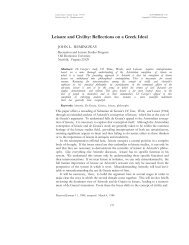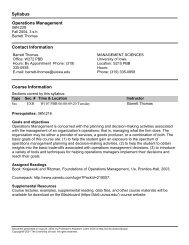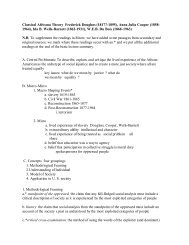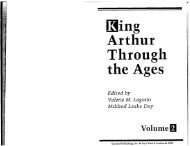Twenty-Five Years of Batson: An Introduction to ... - University of Iowa
Twenty-Five Years of Batson: An Introduction to ... - University of Iowa
Twenty-Five Years of Batson: An Introduction to ... - University of Iowa
Create successful ePaper yourself
Turn your PDF publications into a flip-book with our unique Google optimized e-Paper software.
2012] TWENTY-FIVE YEARS OF BATSON 1419<br />
probably based on race.” 223 “Finally, . . . the general policy <strong>of</strong> the . . . District<br />
At<strong>to</strong>rney’s Office <strong>to</strong> exclude black venire members from juries at the time<br />
Miller-El’s jury was selected” confirmed “the appearance <strong>of</strong><br />
discrimination.” 224<br />
A step-three determination <strong>of</strong> intent required consideration <strong>of</strong> all the<br />
evidence “cumulatively,” and the “direction” <strong>of</strong> the cumulative evidence in<br />
Miller-El was “<strong>to</strong>o powerful <strong>to</strong> conclude anything but discrimination.” 225 For<br />
two excluded jurors, it was unrealistic “<strong>to</strong> deny” that they were struck<br />
“because they were black.” 226 The state court’s contrary conclusion was<br />
clearly and convincingly “wrong” and “unreasonable as well as erroneous.” 227<br />
In 2008, the Roberts Court reached a similar conclusion in another<br />
capital case. In Snyder v. Louisiana, the government “eliminated” all five<br />
black jurors who remained in the pool after challenges for cause. 228 With<br />
respect <strong>to</strong> one strike, seven Justices found “clear error” in the state court<br />
finding that the prosecu<strong>to</strong>r lacked discrimina<strong>to</strong>ry intent. 229<br />
According <strong>to</strong> the Court, the trial judge’s “pivotal role” in <strong>Batson</strong>’s third<br />
step requires evaluation <strong>of</strong> the striking at<strong>to</strong>rney’s “credibility,” and the<br />
at<strong>to</strong>rney’s “demeanor” is <strong>of</strong>ten “the best evidence [<strong>of</strong> discrimina<strong>to</strong>ry<br />
intent].” 230 Moreover, because “race-neutral reasons . . . <strong>of</strong>ten” refer <strong>to</strong> “a<br />
juror’s demeanor,” a judge’s “firsthand observations” <strong>of</strong> jurors can be very<br />
important in deciding whether an explanation accurately describes the<br />
juror’s behavior. 231 The deference <strong>to</strong> a judge’s step-three determination<br />
reflected in the “clearly erroneous” standard <strong>of</strong> review is appropriate<br />
because credibility and demeanor assessments “lie ‘peculiarly within a trial<br />
judge’s province.’” 232<br />
In Snyder, the prosecution <strong>of</strong>fered two reasons for striking one black<br />
juror—that he appeared nervous and that he reported a student-teaching<br />
obligation. 233 The prosecution argued that the latter could make the juror<br />
desire a quick end <strong>to</strong> the trial, prompting him <strong>to</strong> return a lesser verdict <strong>to</strong><br />
223. Id. at 253. For detailed discussion <strong>of</strong> these matters, see id. at 253–63.<br />
224. Id. at 253. For further explanation <strong>of</strong> the policy <strong>of</strong> systematic exclusion, see id. at 263–<br />
64.<br />
225. Id. at 265.<br />
226. Id. at 266.<br />
227. Id.<br />
228. Snyder v. Louisiana, 552 U.S. 472, 475–76 (2008).<br />
229. Id. at 474. The defendant contested two <strong>of</strong> the strikes, but the Court found it necessary<br />
<strong>to</strong> consider only one <strong>of</strong> the two. Id. at 477–78. As in Miller-El, the accused had been convicted<br />
and sentenced <strong>to</strong> death. Id. at 476.<br />
230. Id. at 477 (quoting Hernandez v. New York, 500 U.S. 352, 365 (1991)) (alteration in<br />
original) (internal quotation marks omitted).<br />
231. Id.<br />
232. Id. (quoting Hernandez, 500 U.S. at 365).<br />
233. Id. at 478.

















